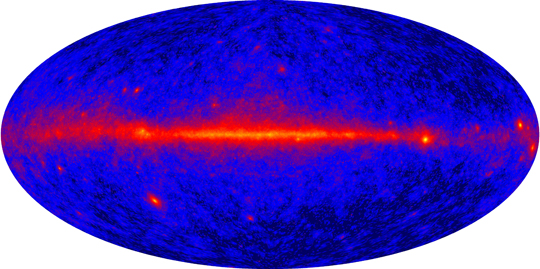M82, the "cigar galaxy" is one of three starburst galaxies now know to radiate gamma rays. Image courtesy of NASA.
The breakfast room was buzzing on Wednesday morning at the Fermi Gamma-ray Space Telescope symposium. The collaboration is definitely excited about the newly observed gamma rays coming from “starburst” galaxies--sites of high numbers of star births and subsequent star deaths. These gamma rays have multiple implications for the astronomical community, most notably providing clues about the origin of cosmic rays.
This is the first observation of gamma rays from starburst galaxies, and astronomers are already eager to revisit other known starburst galaxies, this time looking for gamma ray emissions. If these galaxies emit gamma rays, they would certainly contribute to the diffuse gamma ray background, which is a kind of white noise of gamma rays that comes from every direction in the universe. The source of the background is unidentified but it is expected to have many sources, such as blazars. This background must be subtracted from studies of gamma ray point sources, and it interferes with searches for dark matter, so deconstructing its origins could have widespread implications.
The gamma rays are most likely generated by cosmic rays; but rather than finding that cosmic rays shower down on the galaxies from distant sources, the Fermi results suggest that they are produced inside the galaxies themselves. Cosmic rays are believed to be created when particles are accelerated in the wake of supernova explosions. These cosmic rays then collide with other particles in the galaxy, accelerating them and causing them to radiate gamma rays. So it makes sense that sites of frequent massive star deaths would generate cosmic rays. Fermi scientists also believe the cosmic rays then become trapped in the galaxies by magnetic fields.
The discovery will change the Fermi catalog of objects because “diffuse-gamma-ray-emitting starburst galaxies” are now officially their own object. That is, they will be added as a unique item to the list of objects in the sky. Many point sources of gamma rays have gone unidentified in the past, and Fermi scientists are trying their best to identify and characterize as many as possible.
The Fermi All Sky Map, showing the diffuse galactic background from the Milky Way. Courtesy of NASA/DOE/International LAT Team
What is also notable about this discovery is that the starburst galaxies are more like the Milky Way, and much closer to it, than the very exotic and violent galaxies that contain blazars and other energetic objects more easily seen by Fermi. The Milky Way emits a galactic diffuse emission in gamma rays (which is what creates the colorful band image seen in the Fermi all-sky map). According to a press release from NASA, this is the first time astronomers have seen diffuse emission from star-forming regions in galaxies other than our own.
And there’s more.
Three starburst galaxies were found to emit gamma rays, and two of them, M82 and NGC 253, have also been identified as sources of very-high-energy (VHE) gamma rays by HESS and VERITAS, respectively. While Fermi detects gamma rays with energies up to 300 GeV, observatories like VERITAS (Very Energetic Radiation Imaging Telescope Array System) detect gamma rays in the TeV range (where 300 GeV is .3 TeV).
This the first example of a VHE gamma ray source associated with a starburst galaxy. VERITAS collected the TeV rays from M82 over the course of two years.
Finding that these galaxies radiate in the TeV and the GeV range implies that there is a spectrum of cosmic ray energies, and this could help scientists better understand cosmic rays, where they come from and what they do. “The spectrum is where the real science is,” said Keith Bechtol, a graduate student at Stanford University and SLAC National Accelerator Laboratory, after his talk on Wednesday announcing the discovery of the gamma rays from the three starburst galaxies. “If you want to really understand something, you look at the spectrum.” Bechtol says the next step will be looking and other starburst galaxies for gamma rays.
VERITAS has had a paper accepted in Nature on the subject of these star formation galaxies and cosmic rays.








